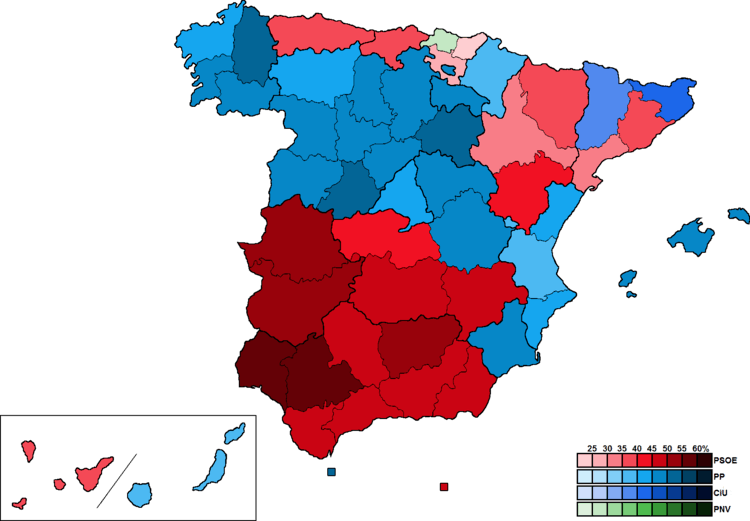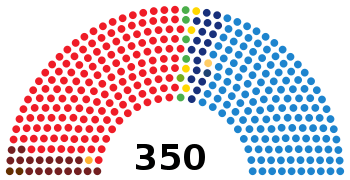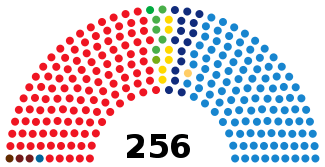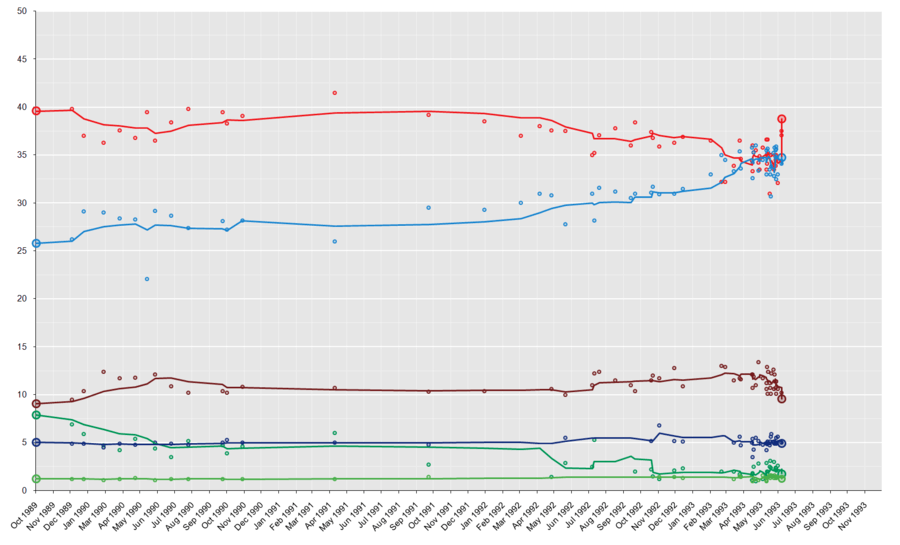Spanish general election, 1993
|
| |||||||||||||||||||||||||||||||||||||||||||||||||||||||||||||||||||||||||||||||||||||||||||||
| |||||||||||||||||||||||||||||||||||||||||||||||||||||||||||||||||||||||||||||||||||||||||||||
All 350 seats in the Congress of Deputies and 208 (of 256) seats in the Senate 176 seats needed for a majority in the Congress of Deputies | |||||||||||||||||||||||||||||||||||||||||||||||||||||||||||||||||||||||||||||||||||||||||||||
|---|---|---|---|---|---|---|---|---|---|---|---|---|---|---|---|---|---|---|---|---|---|---|---|---|---|---|---|---|---|---|---|---|---|---|---|---|---|---|---|---|---|---|---|---|---|---|---|---|---|---|---|---|---|---|---|---|---|---|---|---|---|---|---|---|---|---|---|---|---|---|---|---|---|---|---|---|---|---|---|---|---|---|---|---|---|---|---|---|---|---|---|---|---|
| Opinion polls | |||||||||||||||||||||||||||||||||||||||||||||||||||||||||||||||||||||||||||||||||||||||||||||
| Registered |
31,030,511 | ||||||||||||||||||||||||||||||||||||||||||||||||||||||||||||||||||||||||||||||||||||||||||||
| Turnout |
23,718,816 (76.4%) | ||||||||||||||||||||||||||||||||||||||||||||||||||||||||||||||||||||||||||||||||||||||||||||
| |||||||||||||||||||||||||||||||||||||||||||||||||||||||||||||||||||||||||||||||||||||||||||||
 Constituency results map for the Congress of Deputies | |||||||||||||||||||||||||||||||||||||||||||||||||||||||||||||||||||||||||||||||||||||||||||||
| |||||||||||||||||||||||||||||||||||||||||||||||||||||||||||||||||||||||||||||||||||||||||||||
The 1993 Spanish general election was held on Sunday, 6 June 1993, to elect the 5th Cortes Generales of the Kingdom of Spain. All 350 seats in the Congress of Deputies were up for election, as well as 208 of 256 seats in the Senate.
The Spanish Socialist Workers' Party under Felipe González achieved the largest number of votes and seats for the fourth consecutive time, though it lost its absolute majority in both chambers of the Cortes. In contrast, José María Aznar's People's Party won a large share of the vote, thus increasing their seats in both the Congress and the Senate and consolidating its position as the main opposition party. For the first time since 1979, the election brought in a hung parliament, forcing the governing PSOE to pact with nationalist groups in order to renew their mandate.
In the aftermath of the election, the PSOE saw itself under increased pressure due both to political instability as a result of its low majority (relying on increasingly unstable pacts with Convergence and Union to pass its legislation) and of the uncovering of numerous cases of corruption within the government itself. The pact with CiU would end in the fall of 1995, forcing PM Felipe González to call early elections 15 months before their scheduled date, which would see the opposition right-wing People's Party of Aznar win for the first time.
Overview
Electoral system
The Spanish Cortes Generales were envisaged as an imperfect bicameral system. The Congress of Deputies had greater legislative power than the Senate, having the ability to vote confidence in or withdraw it from a Prime Minister and to override Senate vetoes by an absolute majority of votes. Nonetheless, the Senate possessed a few exclusive, yet limited in number functions—such as its role in constitutional amendment—which were not subject to the Congress' override.[1][2] Voting for the Cortes Generales was on the basis of universal suffrage, which comprised all nationals over eighteen and in full enjoyment of their political rights.[3]
For the Congress of Deputies, 348 seats were elected using the D'Hondt method and a closed list proportional representation, with a threshold of 3 percent of valid votes—which included blank ballots—being applied in each constituency. Parties not reaching the threshold were not taken into consideration for seat distribution. Additionally, the use of the D'Hondt method might result in an effective threshold over three percent, depending on the district magnitude.[4] Seats were allocated to constituencies, corresponding to the provinces of Spain. Each constituency was entitled to an initial minimum of two seats, with the remaining 248 allocated among the constituencies in proportion to their populations. Ceuta and Melilla were allocated the two remaining seats, which were elected using plurality voting.[1][5][6][7]
For the Senate, 208 seats were elected using an open list partial block voting, with electors voting for individual candidates instead of parties. In constituencies electing four seats, electors could vote for up to three candidates; in those with two or three seats, for up to two candidates; and for one candidate in single-member districts. Each of the 47 peninsular provinces was allocated four seats, whereas for insular provinces, such as the Balearic and Canary Islands, districts were the islands themselves, with the larger—Majorca, Gran Canaria and Tenerife—being allocated three seats each, and the smaller—Menorca, Ibiza–Formentera, Fuerteventura, La Gomera, El Hierro, Lanzarote and La Palma—one each. Ceuta and Melilla elected two seats each. Additionally, autonomous communities could appoint at least one senator each and were entitled to one additional senator per each million inhabitants.[1][5][6][7]
The electoral law provided that parties, federations, coalitions and groupings of electors were allowed to present lists of candidates. However, groupings of electors were required to secure the signature of at least 1 percent of the electors registered in the constituency for which they sought election. Electors were barred from signing for more than one list of candidates. Concurrently, parties and federations intending to enter in coalition to take part jointly at an election were required to inform the relevant Electoral Commission within ten days of the election being called.[5][7]
Election date
The term of each House of the Cortes Generales—the Congress and the Senate—expired four years from the date of their previous election, unless they were dissolved earlier. The election Decree was required to be issued no later than the twenty-fifth day prior to the date of expiry of the Cortes in the event that the Prime Minister did not make use of his prerogative of early dissolution. The Decree was to be published on the following day in the Official State Gazette, with election day taking place between the fifty-fourth and the sixtieth day from publication. The previous election was held on 29 October 1989, which meant that the legislature's term would expire on 29 October 1993. The election Decree was required to be published no later than 5 October 1993, with the election taking place on the sixtieth day from publication, setting the latest possible election date for the Cortes Generales on Saturday, 4 December 1993.[5][7]
The Prime Minister had the prerogative to dissolve both Houses at any given time—either jointly or separately—and call a snap election, provided that no motion of no confidence was in process, no state of emergency was in force and that dissolution did not occur before one year had elapsed since the previous one. Additionally, both Houses were to be dissolved and a new election called if an investiture process failed to elect a Prime Minister within a two-month period from the first ballot.[1][6] Barred this exception, there was no constitutional requirement for simultaneous elections for the Congress and the Senate, there being no precedent of separate elections and with governments having long preferred that elections for the two Houses take place simultaneously.
Parties and leaders
Below is a list of the main parties and coalitions which contested the election:
Opinion polls
Campaign
Leaders' debates
| Spanish general election debates, 1993 | ||||
|---|---|---|---|---|
| Date | Organisers | Moderator(s) | P Present | |
| PSOE | PP | |||
| 24 May | Antena 3 | Manuel Campo Vidal | P González |
P Aznar |
| 31 May | Tele 5 | Luis Mariñas | P González |
P Aznar |
| Candidate viewed as "performing best" or "most convincing" in each debate | ||||
|---|---|---|---|---|
| Debate | Poll source | PSOE | PP | Notes |
| 24 May | Demoscopia[8] | 21.0 | 50.0 | 29.0% said none won, that it was a tie or were undecided. |
| Opina[9] | 18.4 | 42.5 | 13.9% said none won, 8.1% it was a tie and 17.2% were undecided. | |
| Sigma Dos[10] | 28.0 | 49.8 | 22.2% said none won, that it was a tie or were undecided. | |
| 31 May | Demoscopia[11] | 48.0 | 18.0 | 34.0% said none won, that it was a tie or were undecided. |
| Opina[12] | 36.2 | 15.3 | 13.6% said none won, 17.4% it was a tie and 17.5% were undecided. | |
Results
Congress of Deputies
 | |||||||||
| Parties and coalitions | Popular vote | Seats | |||||||
|---|---|---|---|---|---|---|---|---|---|
| Votes | % | ±pp | Total | +/− | |||||
| Spanish Socialist Workers' Party (PSOE)1 | 9,150,083 | 38.78 | –1.33 | 159 | –18 | ||||
| People's Party (PP) | 8,201,463 | 34.76 | +8.97 | 141 | +34 | ||||
| United Left (IU) | 2,253,722 | 9.55 | +0.48 | 18 | +1 | ||||
| Convergence and Union (CiU) | 1,165,783 | 4.94 | –0.10 | 17 | –1 | ||||
| Democratic and Social Centre (CDS) | 414,740 | 1.76 | –6.13 | 0 | –14 | ||||
| Basque Nationalist Party (EAJ/PNV) | 291,448 | 1.24 | ±0.00 | 5 | ±0 | ||||
| Canarian Coalition (CC)2 | 207,077 | 0.88 | +0.45 | 4 | +3 | ||||
| Popular Unity (HB) | 206,876 | 0.88 | –0.18 | 2 | –2 | ||||
| Republican Left of Catalonia (ERC) | 189,632 | 0.80 | +0.39 | 1 | +1 | ||||
| The Greens (LV) | 185,940 | 0.79 | –0.11 | 0 | ±0 | ||||
| Aragonese Party (PAR) | 144,544 | 0.61 | +0.26 | 1 | ±0 | ||||
| Basque Solidarity–Basque Left (EA–EuE) | 129,293 | 0.55 | –0.12 | 1 | –1 | ||||
| Galician Nationalist Bloc (BNG) | 126,965 | 0.54 | +0.31 | 0 | ±0 | ||||
| Valencian Union (UV) | 112,341 | 0.48 | –0.23 | 1 | –1 | ||||
| Andalusian Party (PA) | 96,513 | 0.41 | –0.63 | 0 | –2 | ||||
| The Ecologists (LE) | 68,851 | 0.29 | –0.38 | 0 | ±0 | ||||
| Ruiz-Mateos Group–European Democratic Alliance (ARM–ADE) | 54,518 | 0.23 | –0.84 | 0 | ±0 | ||||
| Andalusian Progress Party (PAP) | 43,169 | 0.18 | New | 0 | ±0 | ||||
| Valencian People's Union (UPV) | 41,052 | 0.17 | –0.03 | 0 | ±0 | ||||
| Workers' Socialist Party (PST) | 30,068 | 0.13 | –0.27 | 0 | ±0 | ||||
| Union for the Progress of Cantabria (UPCA) | 27,005 | 0.11 | New | 0 | ±0 | ||||
| Nationalists of the Balearic Islands (PSM–ENE) | 20,118 | 0.09 | +0.05 | 0 | ±0 | ||||
| Regionalist Party of Cantabria (PRC) | 18,608 | 0.08 | New | 0 | ±0 | ||||
| Alavese Unity (UA) | 16,623 | 0.07 | New | 0 | ±0 | ||||
| Liberal Independent Group (GIL) | 16,452 | 0.07 | New | 0 | ±0 | ||||
| Party of Gran Canaria (PGC) | 15,246 | 0.06 | New | 0 | ±0 | ||||
| Leonese People's Union (UPL) | 13,097 | 0.06 | New | 0 | ±0 | ||||
| Natural Law Party (PLN) | 11,392 | 0.05 | New | 0 | ±0 | ||||
| Asturianist Party (PAS) | 11,088 | 0.05 | +0.02 | 0 | ±0 | ||||
| United Extremadura (EU) | 10,653 | 0.05 | ±0.00 | 0 | ±0 | ||||
| Communist Party of the Peoples of Spain (PCPE) | 10,233 | 0.04 | –0.27 | 0 | ±0 | ||||
| Majorcan, Menorcan and Pityusic Union (UMMP) | 10,053 | 0.04 | New | 0 | ±0 | ||||
| Ecologist Party of Catalonia–VERDE (PEC–VERDE) | 9,249 | 0.04 | –0.06 | 0 | ±0 | ||||
| Humanist Party (PH) | 8,834 | 0.04 | –0.04 | 0 | ±0 | ||||
| Revolutionary Workers' Party (POR) | 8,667 | 0.04 | ±0.00 | 0 | ±0 | ||||
| Spanish Phalanx of the CNSO (FE–JONS) | 8,000 | 0.03 | –0.09 | 0 | ±0 | ||||
| Coalition for a New Socialist Party (CNPS)3 | 7,991 | 0.03 | –0.03 | 0 | ±0 | ||||
| Riojan Party (PR) | 7,532 | 0.03 | New | 0 | ±0 | ||||
| Aragonese Union (CHA) | 6,344 | 0.03 | +0.01 | 0 | ±0 | ||||
| Galician Nationalist Convergence (CNG) | 4,663 | 0.02 | New | 0 | ±0 | ||||
| Commoners' Land–Castilian Nationalist Party (TC–PNC) | 4,647 | 0.02 | New | 0 | ±0 | ||||
| Galician Alternative (AG) | 3,286 | 0.01 | New | 0 | ±0 | ||||
| Spanish Democratic Republican Action (ARDE) | 3,063 | 0.01 | +0.01 | 0 | ±0 | ||||
| Regionalist Unity of Castile and León (URCL) | 2,715 | 0.01 | New | 0 | ±0 | ||||
| Party of El Bierzo (PB) | 2,681 | 0.01 | New | 0 | ±0 | ||||
| Extremaduran Regionalist Party (PREx) | 2,086 | 0.01 | New | 0 | ±0 | ||||
| Health and Ecology in Solidarity (SEES) | 1,959 | 0.01 | New | 0 | ±0 | ||||
| Madrilenian Independent Regional Party (PRIM) | 1,917 | 0.01 | –0.01 | 0 | ±0 | ||||
| Gray Panthers of Spain (ACI) | 1,644 | 0.01 | New | 0 | ±0 | ||||
| Valencian Nationalist Left (ENV) | 1,517 | 0.01 | ±0.00 | 0 | ±0 | ||||
| Independent Spanish Phalanx (FEI) | 1,415 | 0.01 | +0.01 | 0 | ±0 | ||||
| People's Palentine Group (APP) | 1,410 | 0.01 | New | 0 | ±0 | ||||
| Rainbow (Arcoiris) | 1,407 | 0.01 | New | 0 | ±0 | ||||
| The Greens of the Alicantine Country (PVPA) | 1,375 | 0.01 | New | 0 | ±0 | ||||
| Cantonal Party (PCAN) | 1,300 | 0.01 | New | 0 | ±0 | ||||
| Regionalist Party of the Leonese Country (PREPAL) | 1,193 | 0.01 | ±0.00 | 0 | ±0 | ||||
| Spanish Catholic Movement (MCE) | 1,178 | 0.00 | New | 0 | ±0 | ||||
| Tinerfenian Assembly (ATF) | 1,159 | 0.00 | New | 0 | ±0 | ||||
| Socialist Party of the People of Ceuta (PSPC) | 1,155 | 0.00 | New | 0 | ±0 | ||||
| Insular Group of Gran Canaria Party (AIGC) | 1,009 | 0.00 | New | 0 | ±0 | ||||
| Castilianist Union (UC) | 949 | 0.00 | New | 0 | ±0 | ||||
| Andecha Astur (AA) | 787 | 0.00 | New | 0 | ±0 | ||||
| Authentic Spanish Phalanx (FEA) | 747 | 0.00 | New | 0 | ±0 | ||||
| Alicantine Democratic Union (UniDA) | 715 | 0.00 | New | 0 | ±0 | ||||
| Progressive Front of Spain (FPE) | 641 | 0.00 | New | 0 | ±0 | ||||
| Union of Autonomies (UDLA) | 594 | 0.00 | New | 0 | ±0 | ||||
| Socialist October (OS) | 540 | 0.00 | New | 0 | ±0 | ||||
| Independent Council of Asturias (Conceyu) | 528 | 0.00 | New | 0 | ±0 | ||||
| Integration Party for Almeria and its Peoples (PIAP) | 466 | 0.00 | New | 0 | ±0 | ||||
| Spanish Balearic Alternative (ABE) | 416 | 0.00 | New | 0 | ±0 | ||||
| Referendum Tolerant Independent Political Party (PITRCG) | 408 | 0.00 | New | 0 | ±0 | ||||
| Party of The People (LG) | 385 | 0.00 | New | 0 | ±0 | ||||
| Nationalist Party of Cantabria (PNC) | 383 | 0.00 | New | 0 | ±0 | ||||
| Federated Independents of Aragon (IF) | 303 | 0.00 | New | 0 | ±0 | ||||
| Radical Balearic Party (PRB) | 282 | 0.00 | New | 0 | ±0 | ||||
| Tagoror Party (Tagoror) | 278 | 0.00 | ±0.00 | 0 | ±0 | ||||
| Regionalist Party of Guadalajara (PRGU) | 267 | 0.00 | ±0.00 | 0 | ±0 | ||||
| Socialdemocrat Spanish Christian Monarchy (MCES) | 244 | 0.00 | New | 0 | ±0 | ||||
| Progressive Sorian Union (US) | 98 | 0.00 | New | 0 | ±0 | ||||
| Nationalist Party of Castile and León (PANCAL) | 70 | 0.00 | –0.01 | 0 | ±0 | ||||
| Initiative for Ceuta (INCE) | 42 | 0.00 | New | 0 | ±0 | ||||
| Communist Unification of Spain (UCE) | 0 | 0.00 | New | 0 | ±0 | ||||
| Coalition for Free Canaries (CCL) | 0 | 0.00 | New | 0 | ±0 | ||||
| Centrist Unity–Democratic Spanish Party (PED) | 0 | 0.00 | –0.02 | 0 | ±0 | ||||
| Freixes Independent Group (Freixes) | 0 | 0.00 | New | 0 | ±0 | ||||
| Blank ballots | 188,679 | 0.80 | +0.11 | ||||||
| Total | 23,591,864 | 350 | ±0 | ||||||
| Valid votes | 23,591,864 | 99.46 | +0.20 | ||||||
| Invalid votes | 126,952 | 0.54 | –0.20 | ||||||
| Votes cast / turnout | 23,718,816 | 76.44 | +6.70 | ||||||
| Abstentions | 7,311,695 | 23.56 | –6.70 | ||||||
| Registered voters | 31,030,511 | ||||||||
| Sources[13][14] | |||||||||
| |||||||||
Senate
 | |||||||||||||
| Parties and coalitions | Directly elected | Regional appointees |
Total seats | ||||||||||
|---|---|---|---|---|---|---|---|---|---|---|---|---|---|
| Total | Seats | +/− | Total | Seats | Total | Seats | |||||||
| Spanish Socialist Workers' Party |
Spanish Socialist Workers' Party (PSOE) | 96 | 90 | –11 | 21 | 19 | 117 | 109 | |||||
| Socialists' Party of Catalonia (PSC) | 6 | ±0 | 2 | 8 | |||||||||
| People's Party | People's Party (PP)1 | 93 | 90 | +14 | 13 | 13 | 106 | 103 | |||||
| Navarrese People's Union (UPN) | 3 | +1 | 0 | 3 | |||||||||
| Convergence and Union | Democratic Convergence of Catalonia (CDC) | 10 | 7 | –1 | 5 | 4 | 10 | 11 | |||||
| Democratic Union of Catalonia (UDC) | 3 | +1 | 1 | 4 | |||||||||
| Canarian Coalition | Canarian Independent Groups (AIC) | 5 | 2 | ±0 | 1 | 1 | 6 | 3 | |||||
| Nationalist Canarian Initiative (ICAN) | 1 | +1 | 0 | 1 | |||||||||
| Majorera Assembly (AM) | 1 | ±0 | 0 | 1 | |||||||||
| Independent Herrenian Group (AHI) | 1 | ±0 | 0 | 1 | |||||||||
| Basque Nationalist Party (EAJ/PNV) | 3 | 3 | –1 | 2 | 2 | 5 | 5 | ||||||
| United Left (IU) | 0 | 0 | –1 | 2 | 2 | 2 | 2 | ||||||
| Popular Unity (HB) | 1 | 1 | –2 | 0 | 0 | 1 | 1 | ||||||
| Aragonese Party (PAR) | 0 | 0 | ±0 | 1 | 1 | 1 | 1 | ||||||
| Basque Solidarity (EA) | 0 | 0 | ±0 | 1 | 1 | 1 | 1 | ||||||
| Riojan Party (PR) | 0 | 0 | ±0 | 1 | 1 | 1 | 1 | ||||||
| Valencian Nationalist Left (ENV) | 0 | 0 | ±0 | 1 | 1 | 1 | 1 | ||||||
| Democratic and Social Centre (CDS) | 0 | 0 | –1 | 0 | 0 | 0 | 0 | ||||||
| Total | 208 | 208 | ±0 | 48 | 48 | 256 | 256 | ||||||
| Sources[15][16][17][14] | |||||||||||||
| |||||||||||||
Aftermath
| Investiture Felipe González (PSOE) | ||
| Ballot → | 9 July 1993 | |
|---|---|---|
| Required majority → | 176 out of 350 | |
181 / 350 | ||
165 / 350 | ||
Abstentions
|
1 / 350 | |
3 / 350 | ||
| Sources[18] | ||
Notes
Bibliography
- Carreras de Odriozola, Albert; Tafunell Sambola, Xavier (2005) [1989]. Estadísticas históricas de España, siglos XIX-XX (PDF) (in Spanish). Volume 1 (II ed.). Bilbao: Fundación BBVA. pp. 1072–1097. ISBN 84-96515-00-1. Archived from the original (PDF) on 24 September 2015.
References
- 1 2 3 4 "Spanish Constitution of 1978". Act of 29 December 1978. Official State Gazette (in Spanish). Retrieved 27 December 2016.
- ↑ "Constitución española, Sinopsis artículo 66". congreso.es (in Spanish). Congress of Deputies. Retrieved 27 October 2015.
- ↑ Carreras et al. 1989, pp. 1077.
- ↑ Gallagher, Michael (30 July 2012). "Effective threshold in electoral systems". Trinity College, Dublin. Archived from the original on 30 July 2017. Retrieved 22 July 2017.
- 1 2 3 4 "General Electoral System Organic Law of 1985". Organic Law No. 5 of 19 June 1985. Official State Gazette (in Spanish). Retrieved 28 December 2016.
- 1 2 3 "Constitution" (PDF). congreso.es. Congress of Deputies. Retrieved 19 June 2017.
- 1 2 3 4 "Representation of the people Institutional Act". juntaelectoralcentral.es. Central Electoral Commission. Retrieved 16 June 2017.
- ↑ "Triunfo claro de Aznar en el primer debate". El País (in Spanish). 26 May 1993.
- ↑ "Aznar superó a González en el debate". La Vanguardia (in Spanish). 26 May 1993.
- ↑ "Las encuestas de "El Mundo", "La Vanguardia" y "El País" dan el triunfo a Aznar". ABC (in Spanish). 26 May 1993.
- ↑ "Victoria neta de González sobre Aznar en el segundo cara a cara televisivo". El País (in Spanish). 2 June 1993.
- ↑ "González ganó por 20,9 puntos a Aznar". La Vanguardia (in Spanish). 2 June 1993.
- ↑ "Electoral Results Consultation. Congress. June 1993. National totals". infoelectoral.mir.es (in Spanish). Ministry of the Interior. Retrieved 24 September 2017.
- 1 2 "General election 6 June 1993". historiaelectoral.com (in Spanish). Electoral History. Retrieved 24 September 2017.
- ↑ "Electoral Results Consultation. Senate. June 1993. National totals". infoelectoral.mir.es (in Spanish). Ministry of the Interior. Retrieved 24 September 2017.
- ↑ "Senate Election 1993". historiaelectoral.com (in Spanish). Electoral History. Retrieved 24 September 2017.
- ↑ "Senate Composition 1977-2017". historiaelectoral.com (in Spanish). Electoral History. Retrieved 24 September 2017.
- ↑ "Congress of Deputies: Most important votes". historiaelectoral.com (in Spanish). Electoral History. Retrieved 28 September 2017.
.jpg)
.jpg)
.jpg)
.jpg)


